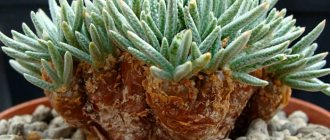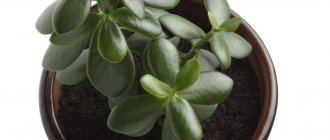The soil
A comfortable environment for cacti is loose, slightly acidic soil that allows air and water to pass through well. A mixture of coarse river sand, leaf humus and turf soil in equal proportions would be ideal. Stagnant water is not allowed for cacti. Therefore, it is important to make good drainage at the bottom of the pot, consisting of brick chips, expanded clay or gravel.
Subterrania parody
This species is reputedly almost entirely hidden under the soil (in its habitat) and is extremely difficult to find in the wild unless it is in flower.
The stem of the cactus has a spherical shape (sometimes slightly elongated vertically) and rarely branches. Size: 6-12 cm in diameter.
With proper care, this cactus will delight you with its pleasant blooms.
15
Landing
Before transplanting the cactus into another pot, you need to stop watering for a few days - this will make it much easier to remove the root from the ground. After the drainage layer, 1/3 of the soil mixture is poured into the new container. Next, carefully immerse the roots in it and sprinkle with the remaining soil. The root collar is sprinkled with river sand.
In order for the wounds of the root system to heal after transplantation, the soil is not moistened for several days. It is enough to replant an indoor cactus only once every couple of years.
Beautiful cactus Discocactus (Discocactus horstii)
Discocactus horstii species
In adulthood, it forms the so-called
cephalium
- a perennial inflorescence from which
large white flowers
. In the early stages of development, the cactus is green in color, but later acquires a red tint.
10 rarest flowers
Although it looks like a common desert cactus when young, this cactus species grows at altitudes of at least 300 meters
above sea level. It is quite difficult to grow at home, since it really does not like overwatering and can easily rot from high humidity. If you water it rarely, the cactus will dry out quickly, although most cacti cope with this task with ease.
Rainbow Hedgehog Cactus
This species is cylindrical or oval in shape, up to 45 cm tall. It is impressive with its color range - pink and purple shades.
This cactus is quite comfortable without shading from the bright sun, on the south and west side. Echinocactus favorably tolerates dry air, but also does not mind periodic spraying with sufficiently warm water.
This breed has an extremely fragile root system, so the inevitable replanting must be extremely careful.
The Amazing Schlumbergera
The second name of this flower is Zygocactus, but most often it is called Decembrist or Rozhdestvennik, because it actively blooms during the winter New Year holidays; it belongs to the genus of epiphytes with delicate and transformed spines.
When growing cacti that bloom at home, it is better to protect the shoots from direct sunlight; the color range of flowers is very diverse with a predominance of red and pink shades.
Opuntia microdasys (Prickly pear)
It is highly undesirable to touch any type of prickly pear. Its miniature spines with jagged ends prick very painfully. Prickly pears grow up to 30 cm and come in a variety of shapes.
In summer, the cactus is watered abundantly, but during periods of extreme heat, watering is reduced and done only in the evening. In this case, moisture should not get on the stems.
Delicate flowers of Gymnocalycium
A unique feature of this plant is the ability to cultivate exclusively grafted forms of the flower, which begins to bloom after 2-3 years of growth, and flower buds form in the spring season.
Seeds obtained at home are not suitable for propagation, but during flowering the buds open and the grower will be pleased with exceptionally delicate and magnificent flowers in yellow, green or red shades.
Trichocereus candicans
Can grow up to 1.5 meters. It features white, funnel-shaped, fragrant flowers.
Depending on the species, the stem can grow vertically or obliquely. The length of the spines on the ribs reaches 4 cm, in the center - 2 times longer.
The plant is very hardy and unpretentious, gaining height and expanding easily with plenty of sunlight, warmth and regular watering.
Unusual cactus Pereskiopsis spathulata
Some cacti have both leaves and spines
.
One of them, the original Pereskiopsis spathulata
, has a stem from which leaves and spines grow simultaneously.
This type of cactus grows in tropical areas and grows very quickly. It is often used for grafting to speed up the growth of young growth of slower species of cacti
.
Although the cactus P. spathulata
capable of blooming, this happens extremely rarely.
It reproduces mainly by the fact that numerous shoots
, which are clones of each other. These shoots can be torn off and planted separately.
Holiday Cactus (Christmas or Schlumberger)
The plant impresses and pleases with its beautiful flowering in winter, which is unusual for cacti.
Therefore, it is in winter that Schlumberger will need intensive watering. For such a cactus, diffused sunlight is more acceptable. The palette of shades of flowers 7-8 cm long can be very different.
The history of the origin of large cacti
Fossil remains of the cactus have not yet been found, so it is difficult to accurately say their age and origin. However, there are scientists’ assumptions that these amazing representatives of the flora are about 20 thousand years old. If this is so, then cacti are the youngest plants on Earth.
They came from ordinary plants that are more familiar to us. Cacti acquired their appearance and their amazing resistance to harsh living conditions due to many years of changes and adaptation. When ordinary plants began to experience conditions of moisture deficiency and scorching sunlight, they needed to somehow adapt in order to survive. The leaves turned into thorns, the trunks into a base capable of retaining moisture for a long time.
Thanks to their ability to adapt and survive in difficult conditions, cacti have spread to almost all continents of the globe. For example, in India, Bali, and Australia, prickly pear is widespread. But the homeland of this plant is in a completely different place.
The historical homeland of cacti is arid South America. And their ancestors were moisture-loving vines. Most of them died out in the severe droughts of the deserts, and only a few representatives survived due to the reduction of leaves. Then they began to spread throughout the United States, and from there to other countries. There are especially many in the states of Texas, Arizona and New Mexico. On their territory you can find cacti several hundred years old and of enormous size.
Due to their ease of care and cultivation, unusual appearance and diversity, cacti have become a popular indoor plant. They are often found not only in apartments, but also in offices and workplaces.
Mammillaria (Mammillaria)
This plant has up to 500 varieties. Mammillaria are covered with long soft spines, like hairs. The stems come in spherical or cylindrical shapes.
Their characteristic difference from other representatives is the presence of many papillae. Flowers of purple, white, and red tones grow from the axils located between the papillae.
Notocactus ottonis (Notocactus Otto)
Flower growers grow this species not so much for the sake of flowering, but for the interesting structure of the stem with pronounced ribs, on which hard spines look very nice.
Over time, large glossy yellow flowers appear, the diameter of which reaches 8 cm. The result is an expressive contrast against the bright green background of the stem, which adds even more attractiveness to this breed.
Varieties of cacti and growing at home
Over the years of the spread of cacti, many varieties have been developed that can be grown at home. They have different shapes of the plant itself, spines, flowering, planting and care features.
Home cactus Aporocactus
Aporocacti, or forest cacti, are easily identified by their appearance. They have long, thin shoots that seem to droop. They need to be planted in a pot, in a suspended state. This type of cacti is distinguished by large, often red, flowers that bloom only during the day.
The Mexican state of Hidalgo is considered the homeland of these plants. There, aporocacti grow on trees in arid climates, hanging from them like vines. Closer to rocky areas, they grow right on the rocks, forming bizarre species.
Aporocacti are quite unpretentious in care. They are very light-loving, so they will feel bad in the shade and will not please their owners with their beautiful flowers, for which they are especially valued. But in summer it is worth protecting it from direct scorching sunlight.
To grow aporocactus at home, you should prepare good, suitable soil. It should be a well-permeable substrate with the addition of sand, perlite and a small amount of sphagnum. Don't forget about the drainage layer. Aporocacti have rather long roots, so the container for growing should be chosen to be deep but of small diameter. There are varieties of this species that do not grow large.
Aporocactus can tolerate winters with temperatures not lower than 6-8°C. In winter and short daylight hours, the plant will be dormant. It is important to provide him with the maximum amount of sunlight so that he gains strength and prepares for the spring period. With the arrival of spring, the aporocactus will begin to awaken, gain strength for flowering and further growth.
It is recommended to replant the plant either before the arrival of spring and awakening, or at the end of autumn, when it is ready for winter and the dormant period. In the stages of awakening and active growth, transplantation is categorically not recommended. Since during this procedure the roots of the plant may be damaged and it will take time and effort to restore them.
This type of cactus is especially susceptible to spider mites. It is important to place it in a well-ventilated place, but without drafts. Also, in summer, take it out into the open air. And of course, keep an eye on other indoor plants to prevent infection.
Astrophytums
Astrophytums are a type of flowering cacti with beautiful buds. They are distinguished by ribs on the plant itself and white specks on the surface of the stem.
The hot regions of Mexico and Texas are considered the birthplace of astrophytum. In the deserts of these countries there are specimens that are hundreds of years old and reach incredible sizes. Due to their unusual, ribbed shape, exoticism and unusual flowers, they have become widespread as a houseplant. Astrophytum is a popular type of cactus for growing at home.
This plant is very light-loving, so it is best to grow it in southern windows with the maximum amount of sun. It is best to choose a soil with a mineral substrate, well-penetrating and draining. This type of cactus does not have very large, but strong roots, so the growing container is small, the size of the plant.
In winter, you should avoid watering the plant, as it will be in a dormant stage. It is advisable to maintain a temperature regime that is comfortable for astrophytum. They tolerate air temperatures of at least 8°C.
Among astrophytums there are varieties with different types of spines, and there are also representatives without them at all (speckled astrophytum). Several varieties of hybrid astrophytums have also been bred.
This type of cacti is capable of growing to large sizes over time, provided comfortable conditions are met. However, only small astrophytums bloom. The older the plant, the less often it blooms. And over time it will stop completely. However, the stems of this cactus are beautiful and unusual in themselves.
Cephalocereus
Cephalocereus is a species of furry cactus. Mexico is also considered its homeland. Due to its very unusual appearance, this cactus has become widespread and popular as a houseplant. Long, silver-gray hairs completely cover the stem of the plant, protecting it from exposure to direct, scorching sun rays and winds.
However, there is a plant variety - Cereus Peruvian. It also belongs to the Cephalocereus species, but does not have hairiness. It is distinguished by abundant, large flowers and a very unusual shape. The trunk of this variety is distinguished by strong branching, which cannot be said about other cacti.
This type of large cactus is unpretentious, so it is quite easy to grow. Prefers a bright place, loose, penetrating soil mixed with sand. In winter, an air temperature of at least 8°C is also recommended.
Cleistocactus
Cleistocactus is a rare species of large cacti. The long cactus has a tall stem and unusual spines. It reaches a large size in height; on average, at home it grows from 40 to 60 centimeters. Some varieties, when they reach a height of 20-30 centimeters, begin to bloom. The flowers of this type of cacti are very unusual - elongated, tubular, covered with a scaly layer. They are adapted for pollination by hummingbirds in natural conditions. The spines completely cover the stem of the plant; depending on the species, they can be very small or larger, but are often located.
This species prefers a bright place, but it must be protected from direct sunlight. Loves moderate watering, well-penetrating soil. During the growth period, it is necessary to feed the plant with fertilizer. You can choose a universal one for indoor plants, or choose a special one for cacti. In winter, it is important to water infrequently so as not to overwater the plant.
Echinofossulocactus
A special feature of this type of cactus is the wavy ribs along the entire stem. Due to this they look very interesting and unusual. The plant is covered with rather large spines. Young specimens of this species can bloom with small but beautiful flowers.
This species does not require special conditions for care. It is best to avoid direct sunlight during peak activity. Prefers moderate moisture. The dry steppes of Mexico are considered the homeland of this species, so the plant prefers loose, more fertile soil.
Echinopsis
This type of cactus combines several varieties. They bloom quite often, with beautiful, free-standing flowers. In this species, there are varieties that reach large sizes, and there are representatives with sparse spines or completely covered with them.
The ferocactus variety is a spherical plant with a ribbed base and fairly large spines. Over time and under comfortable conditions, it can reach very large sizes.
For this type of cacti, it is important not to be in direct hot sunlight, a penetrating and draining substrate and the correct growing container. It is important to choose a container that is deep and has a suitable diameter in order to grow a large cactus at home.
Prickly pear
Prickly pear is a type of flat cactus. This species is especially common in the Mediterranean. It reproduces very easily and takes root in a new place. Opuntia can reach enormous sizes. There are specimens in nature that are tens of times larger than humans. It is also quite easy to grow large prickly pear at home. To do this, you just need to maintain comfortable conditions for her.
Prickly pear loves moist, fertile, loose soil. It is better to avoid direct sunlight on the plant, otherwise it may get burned. For growing, it is best to choose a large, spacious container. Prickly pear does not like cramped, confined spaces.
Selectors have developed many varieties of prickly pear, including decorative ones. They differ in the color of the stem, shape and abundance of spines. It is important that prickly pear should never be handled with bare hands. On the surface of the plant there are many hook-shaped spines that are not visible to the naked eye, but can get on your hands and cause inflammation.
Large cacti are the most unpretentious and unusual representatives of indoor plants. With proper care and comfortable conditions, you can easily grow the largest indoor cacti. Choose the variety you like, provide the plant with care and a suitable place, and soon the cactus will delight you with its unusual appearance and size.
Currently reading:
- Flowering of capricious oncidium, after careful transplantation
- Choosing cucumbers for open ground according to your preferences
- Planting to decorate the site with three types of coniferous trees
- Tips for keeping poinsettias at home
Share the news on social networks
About the author: Victoria Semyonovna Nakhodkina
Leading researcher at the laboratory of vegetable and berry crops, Yakut Scientific Research Institute of Agriculture, Siberian Branch of the Russian Academy of Agricultural Sciences, Republic of Sakha (Yakutia).
Rebutia miniscula (Tiny rebutia)
These cute little cacti are spherical in shape with a diameter of no more than 10 cm. Tiny Rebutia differs from other similar species in the placement of flowers - not at the top of the stem, but at its very base.
Flowers, as a rule, have a pink, orange, red tint, and even the golden color of the spines of the rebutia makes it especially decorative.
This cactus is very favorable to dry air, but requires mandatory spraying in the morning from a spray bottle. Basically, the plant requires the same conditions as other indoor cacti.
Do you have cacti at home? What types are your favorite?
Rhipsalis
Rhipsalis, or, as it is also called, Easter cactus, differs from its relatives in the absence of spines, instead of which there are tufts of soft bristly pubescence on the thin long stems of rhipsalis. Rhipsalis is also called twig, which most closely matches its species. The most common option for placing it is in hanging pots, which allows the branches of this cactus to grow unhindered, hanging down.
Like many other cacti, rhipsalis blooms in winter. During the flowering period, its branches are covered with small white (less often yellow, black or pink) flowers. In addition, the twig produces small berry-like, juicy fruits. Recently, there has been an active process of cultivating rhipsalis as a houseplant or greenhouse plant.











